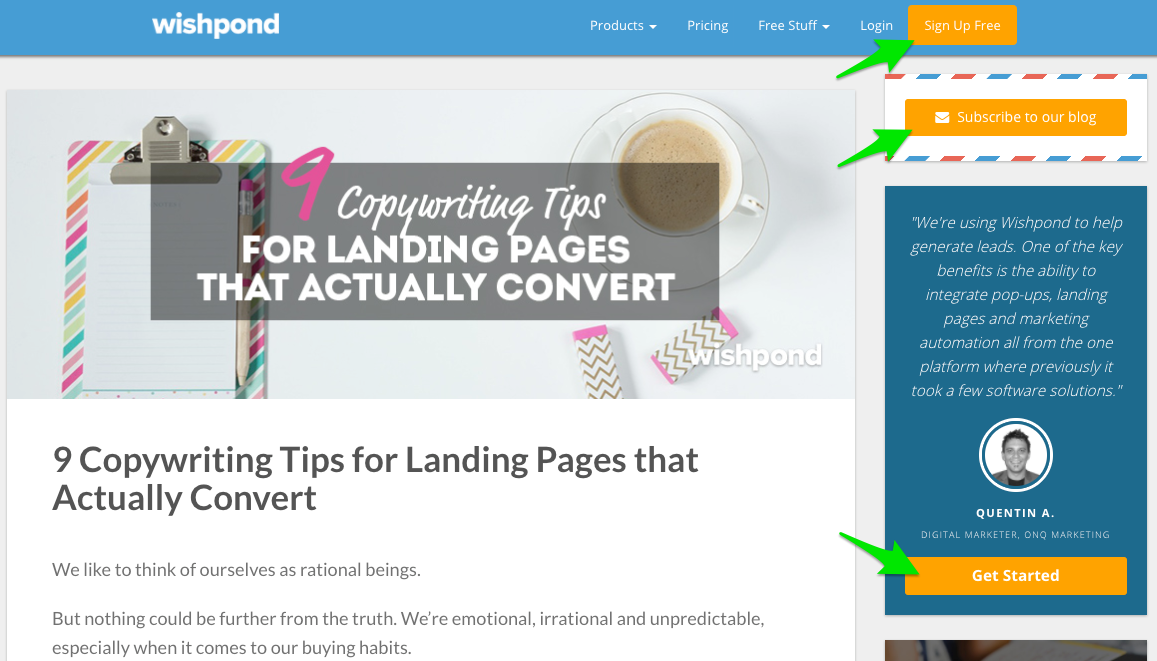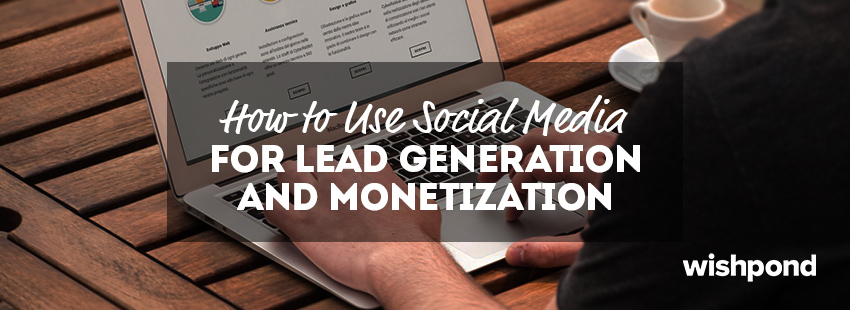“When you enchant people, your goal is not to make money from them
or to get them to do what you want, but to fill them with great delight.”
– Guy Kawasaki
Hi. It’s just you and me here, so let’s be honest for a moment.
We’re in this for the money.
Your business, just like my business, is For Profit. It’s designed to profit — to be profitable. It’s a business, not a non-profit organization devoted to saving a particular species of grass.
And it’s OK to want to make money! There’s nothing wrong with making sure that you’re able to provide for yourself and your family, and have an income with which to do the things that interest you.
So why lead with a quote from Guy Kawasaki that talks about how making money isn’t the goal?
Because he’s right.
Or rather, he’s partly right.
Having followers and readers on social media who are enchanted with you sounds awfully good, doesn’t it? Since you’re not Merlin, we’re going to go with the more common definition of “to enchant” as to mean: fill (someone) with great delight; charm.
To captivate. To fascinate.
Few would argue that having a captivated audience on social media is a bad thing.
However, should that really be the goal? Or, perhaps, is it possible to have more than one goal?
Is it reasonable to suggest that brands and solopreneurs could and should strive to both captivate and communicate? Enchant and enlighten?
I think so.
Otherwise, using social media on behalf of a brand is nothing more than an exercise. The activity has to result in measurable traffic, leads and sales.
To that end, we’re going to cover the kind of content and activity to share to social media. The kinds of social posts that can potentially result in hitting both of these lofty goals.
We’re also going to explore how you can leverage your growing social audience for more than just referral traffic.
That’s not to say that referring traffic isn’t important — it is. So we’ll talk about that too; specifically, where to send that traffic.
Finally, we’ll take a look at how some businesses are able to monetize their social media activity itself.
Ready? Let’s get started.
Engage, Entertain, Educate (& Enchant)
“The best way to engage honestly with the marketplace via Twitter is to never use the words ‘engage,’ ‘honestly,’ or ‘marketplace.’”
– Jeffrey Zeldman
Whenever I talk to a blogger or business owner about how to use social media and what to post, I start by explaining the 3 E’s:
- Engage
- Entertain
- Educate
And of course, thanks to Guy we now have to add Enchant, though that might apply to the overall effect we’re going for.
These clever alliterative actions give you an ideal framework for creating an active, successful social presence, regardless of network. In fact, it’s a smart ploy to use all three post actions in that order. More on that in a moment.
Engage
An engaging post on social media is a little bit different from something that’s engaging outside of social media. On social networks, what we’re looking for is activity on the post itself.
Likes, Comments, Shares. That kind of thing.
That’s social engagement. More than just a vanity metric, post engagement is a very real indicator of audience interest in your post and social presence, and it’s something that the networks themselves pay close attention to.
The more engagement your posts receive, the more likely they are to be seen by more of your fans.
Plus, when people engage with your posts it increases the possibility that their connections will see that post and thereby grow your visibility.
So, it’s important to create social posts that encourage engagement. While you shouldn’t specifically ask for Likes, it’s definitely a good idea to share content that people are more prone to Like (great images) or Comment on (ask a question or start a great discussion). And the best is when the post is so good audience members cannot help but to Share it — the ultimate form of social media engagement.
Post Planner is fantastic for surfacing content, particularly for Facebook, that’s proven to be good at generating fan engagement.
Entertain
Serious discussions and conversations are great, but the fact is, most people use social media as a place to catch up with what their contacts are doing and relax for a bit.
They might open Facebook on their phone while standing in line to check out, or scroll through their favorite Twitter list over lunch.
That means, depending on their current mood and timing, they may not be interested in jumping into an intense discussion.
That’s where memes, GIFs, videos, jokes and other entertaining content can be of real value.
Not only do they break up the monotony of what you have going on with your page and business, they also provide much-needed respite to your already overwhelmed audience.
Will you catch all of your audience members at the ideal time with all of your content? Of course not. However, do give careful consideration to your ideal audience member’s typical schedule and frame of mind, and plan your posts accordingly.
It just might be that a funny cartoon shared during the lunch hour is the best approach.
Educate

The Educate style of post is my personal favorite — and it’s also the most critical to the success of your business.
This is where you bring home the bacon.
While some educational posts might talk specifically about your business, the best-performing content will do two things:
- Help your target audience understand something they need to know that’s related to your niche and business.
- Lead those who need additional help into your sales funnel.
The education can happen on the social post itself (if relatively brief), or within a piece of content that’s on your website that you’re sharing to social (like a blog post).
Wishpond, for instance, has a great article designed to help people who struggle with what to say on their landing pages, titled, “9 Copywriting Tips for Landing Pages that Actually Convert.” People interested in reading that article are specifically looking for advice on how to make their sales pages more effective. Both within and around the content are strong lead-ins to Wishpond’s landing page tools for those who need that kind of help.

Now, if you were to create three Facebook Page posts for tomorrow using all three of those approaches, the process might look like this:
First, you’d create a post that invited your Facebook audience to participate in a discussion of some kind. Then, you’d share a post that’s particularly funny or entertaining. Finally, you’d share something that’s more educational in nature regarding your niche or business.
That’s referred to as priming your audience, and it works particularly well on Facebook where each successive post’s Reach is, in part, determined by the most recent previous posts.
By getting your audience interested and engaged in your initial posts, you are engineering it to be more likely that your audience will both see and be receptive to your final and most important piece of content.
So, up until this point, we’ve looked at the different types and goals of posts that you can create. Now you’re ready to build on that and take your social media activity to the next level.
Build Relationships
“Smart phones and social media expand our universe. We can connect with others or collect information easier and faster than ever.”
– Daniel Goleman
Sharing posts and content that are designed to get your audience to engage with you and become educated about your business is just the beginning.
It’s time to put names and identities to those audience members.
Of course, most of your social media posts are going to receive interest from individual people with names, so what, exactly, am I talking about here?
As a precursor, if you haven’t already, take the time to create Buyer Personas for your business. While everyone you’re going to deal with on social media may be a unique individual, it can be very helpful to have taken the time upfront to develop personas.
Those personas will enable you to be aware of your target audience’s issues and needs so that you can meet and exceed their expectations.
Relationships. Specifically, getting to know the people that you are connecting with on your primary social channels.
These connections will generally fall into one or more of the following categories:
- Personal
- Coworkers / Colleagues
- Prospects / Customers
- Influencers
- Brands / Vendors
This is an important distinction to let settle in the back of your mind. Not all of your social connections are going to be potential customers. Everyone will have their own agenda and reason for following you, and it’s important to discern what that might be (some might even be competitors!).
Focusing on Prospects / Customers for a moment, these people have likely chosen to follow you on social media in order to have dialogues with you and get more assistance within your area of expertise.
So give them what they want.
Being generous and personable with your time is what makes great brands and businesses stand out on social media. Customers love it when brands respond and act like, well, they’re not brands. Like they’re real people.
Bryan Kramer, an acclaimed social media expert and keynote speaker, has written a book about how brands need to communicate in a way that’s more Human to Human. He says, “The fact is that businesses do not have emotion. Products do not have emotion. Humans do. Humans want to feel something.”
Whether you’re connecting with customers or colleagues or companies, your best strategy is to leverage the personal nature and immediacy of social media to create rich relationships.
- Respond to comments and questions.
- Comment on other people’s posts.
- Share real stories and speak in a personable way.
As you have more frequent conversations with individuals, make every effort to remember the details of those conversations, just as you would if you were attending networking events or meetings.
That will help you not only identify potential customers, but also possible brand evangelists and influencers. Such awareness of relationships will create opportunities.
Opportunities like sharing the right piece of content at the right time.
Distribute Lead Generation Content
“Good content always has an objective; it’s created with intent.
It therefore carries triggers to action.”
– Ann Handley
Social Media
Many brands use social media to broadcast. They try to tell the world that they’re having a sale, or have published a new blog post. Unfortunately, the reality is that most of the world doesn’t care.
I’m not being cynical here, just a realist. After spending many, many years blogging, I can safely say that I have never had a blog post where even 1% of the known world felt they absolutely had to read it.
That’s not to say that brands and bloggers shouldn’t share blog posts, epic content and landing pages to social media — just that they need to have realistic expectations.
First, the content needs to be created with both the target audience and end goal in mind. Are you trying to make a sale? Obtain an email address from a potential client? Something else?
Sharing that content to your social networks and other distribution channels, if appropriate, is certainly a next step. But, there’s an even more effective use of the content over time.
As answers to questions.
Today, for instance, I was glancing through some posts in a popular Facebook Group for social media managers. I saw a question that I knew that I could help with. This individual was lamenting the fact that 98% of the direct messages he receives through Twitter are spam. And yet, there are still 2% that are valid messages, potential opportunities even, but they’re being drowned out and overwhelmed.
He wanted to know if there was a way to first clean up his Twitter Inbox of all the existing junk messages, and then somehow filter out the incoming spam going forward so that he only sees the relevant messages.
Turns out, that’s something I wrote about, called “Get Your Social Media Inbox To Zero,” which I was able to tell him about and link to.
Not only did I answer his question and solve his problem, but the solution is to use AgoraPulse, for which I have an affiliate link within that article, so the solution “makes a sale” for me while simultaneously helping that individual.
What’s more, that’s a group filled with 30,000 members, many of whom will see that post and my comment, potentially resulting in additional clicks and signups.
That’s when the combination of social media and lead generation content can be particularly powerful.
Once you have the blog posts or landing pages in place, it’s just a matter of paying attention and watching for opportunities to provide helpful, relevant links.
Forums
Let’s not forget about the original form of the vehicle that was “social” well before “social” was a thing. Forums are still a strong way for people to meet and interact. It’s dramatically different. Once understood, you may find benefit for your own business. Here’s how to think about them in “The Era of Social”…
A discussion in forums is longer-term in nature. While most social conversations are done in a matter of minutes to days, forum threads can run from days to years (yes, years!).
Over time, they grow content considerably, becoming findable in search if they are left open to the search engines. Pulling long-tail traffic at first, a forum in your niche can deliver significant search traffic.
Don’t hold your breath if you are expecting your Facebook content to get found by anything more than a search on your name!
There are two types of forums:
1) Open (search-indexable) forums attract people knowledgeable in a niche who participate purely for the love of it (e.g., the grandaddy of audio-visual forums, AVS. Traffic is high. Ads, sponsors and special promotions pay the bills and then some!).
2) Closed forums are usually part of a product (e.g., a feature of a membership site). Participants here are more focused. Having paid for a product, these communities “self-select” into a highly engaged community.
A hybrid model exists, too. The SBI! Forums recently launched an interesting technique to capitalize upon the hundreds of thousands of threads. They anonymized the participants for non-logged-in guests, opening the content to Google while retaining their users’ privacy.
The near immediate result of “opening the closed” forums speaks for itself (a tripling of traffic from a steady baseline of ~400 to 1200 and climbing):

There is a second major benefit, too. Folks who find the SBI! Forums are fairly targeted visitors. They access the product via a kind of backdoor, getting an insight into one of SBI!’s features — high-level, friendly and helpful solopreneur discussions that move each other ahead in their business efforts.
The user is also exposed to “ads.” The difference from AVS is that these ads are for the product itself (see the right sidebar in the screenshot below, and click here to explore for yourself).

Open, closed or hybrid, forums are another rich source of opportunities to answer questions and develop relationships.
Brand Partnerships
“Social media is not just a spoke on the wheel of marketing.
It’s becoming the way entire bicycles are built.”
– Ryan Lilly
Now, do you always have to send traffic from social media to your business website to monetize social? Of course not.
For example, if you make it clear on your social channels, through your bio and within the context of your shares, that you’re available for hire, people will contact you through social.
Social networks are also increasingly making it possible for customers to make purchases directly via the network, such as Buy buttons on Pinterest pins.
But what’s really interesting (and lucrative) is the growing need that brands have for influencers and micro-influencers.
That’s where you and your audience come in.
You see, savvy brands recognize that, over time, you’ve developed a rapport and reputation with your audience. You’ve been sharing helpful information and positioning yourself as an expert in your field.
Your audience has come to know, like and trust you.
Therefore, if you were to talk about a brand on your social platform, your audience would pay attention. And if you were to mention that brand on a recurring basis, the brand’s awareness and adoption levels could rise dramatically within your sphere of influence.
That’s worth something.
The larger and more targeted your niche and audience, the more valuable it might be.
Of course, the trick is finding and connecting with brands that are interested in and willing to work with you. Most won’t advertise that they’re looking for influencers to partner with — you will have to dig for that.
There’s a new network though, called Trafeze. It hopes to make that process immensely simpler and, by extension, make your influence far more profitable.
As a “seller” you simply sign up for free on Trafeze and apply to create a listing that has your name, website, social profiles, and a bit about who you are and what kinds of monetization deals you’re interested in.
Those that have good traffic numbers and/or engaged social profiles get accepted! Once brands and businesses that want to “buy” traffic and influence are allowed in, they’ll be able to search specific industries and niches, find you, and reach out to you to create a real, profitable partnership.
Being able to monetize your social audience is a tremendous asset, and you’re not out anything for trying, so do set up a listing for yourself.
Wrapping Up
We’ve covered a lot of ground in this post, so let’s come up for air and review what we’ve learned.
First, we talked about the 3 E’s and how important it is to always make sure that your social media posts are engaging, entertaining, and/or educating your audience.
If you’re able to do all three, consistently, you’ll achieve an enchanting social presence that would make Guy (and me) proud.
Second, we learned how to use social media to help people find our most important blog posts, epic content and landing pages — through both distribution and direct links in appropriate discussions and answers.
And finally, we saw that it’s quite possible to make money directly from your social profiles and posts, and I shared a resource you can use to make that happen.
I know that much of this is still at a very high level for you. It’s incumbent on you now to think about the concepts I’ve shared, take them back to your business, and see how they can apply to you and your specific audience and goals.
Have a question? Not sure how to apply a specific recommendation? I’d love to hear from you in the comments below.
 About the Author:
About the Author:
Mike Allton is the CMO for SiteSell. As a Content Marketing Practitioner, he has spent years learning and testing blogging and social media tools and techniques, and has leveraged that experience as an award-winning blogger at The Social Media Hat. Catch him online at @Mike_Allton.


